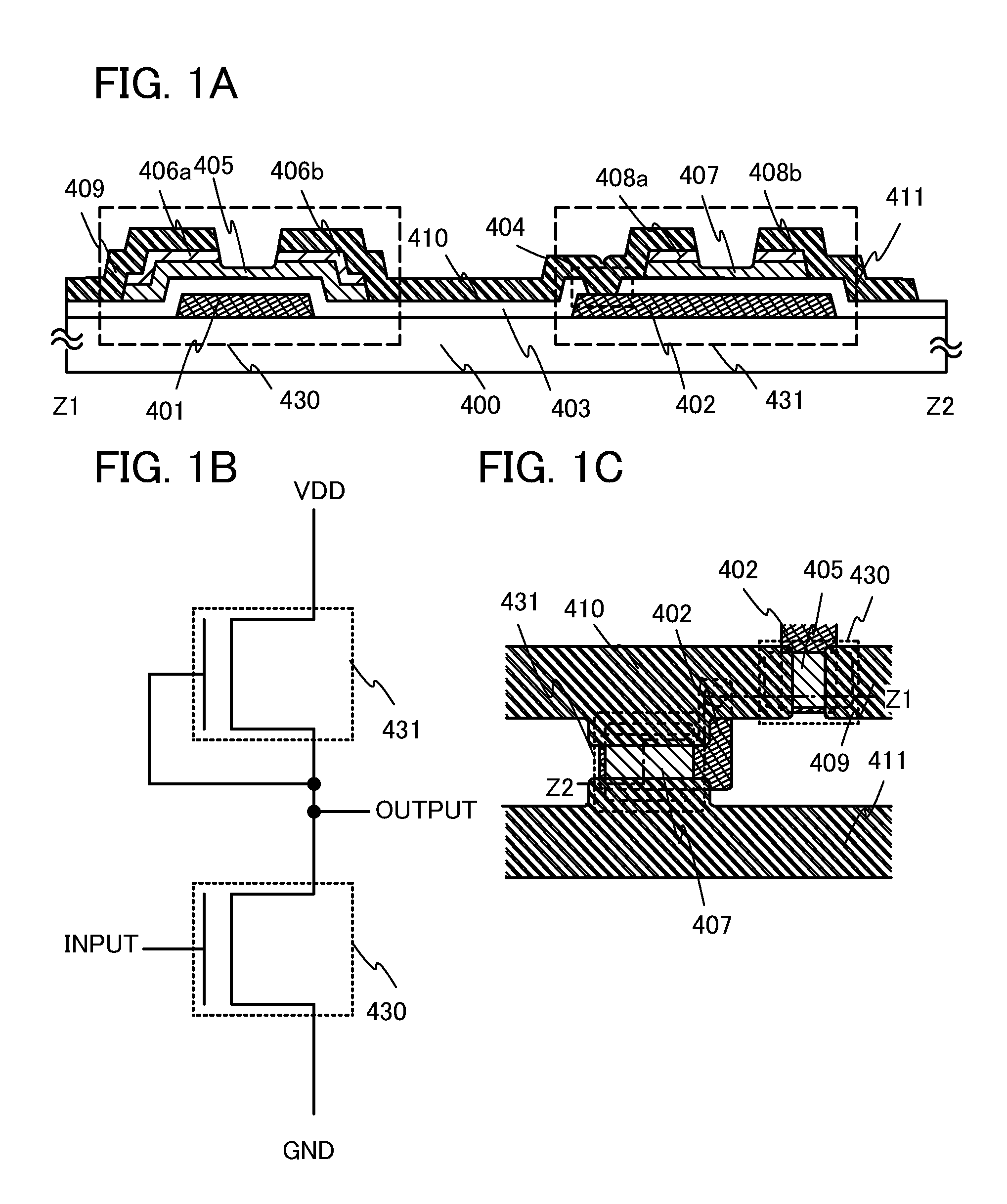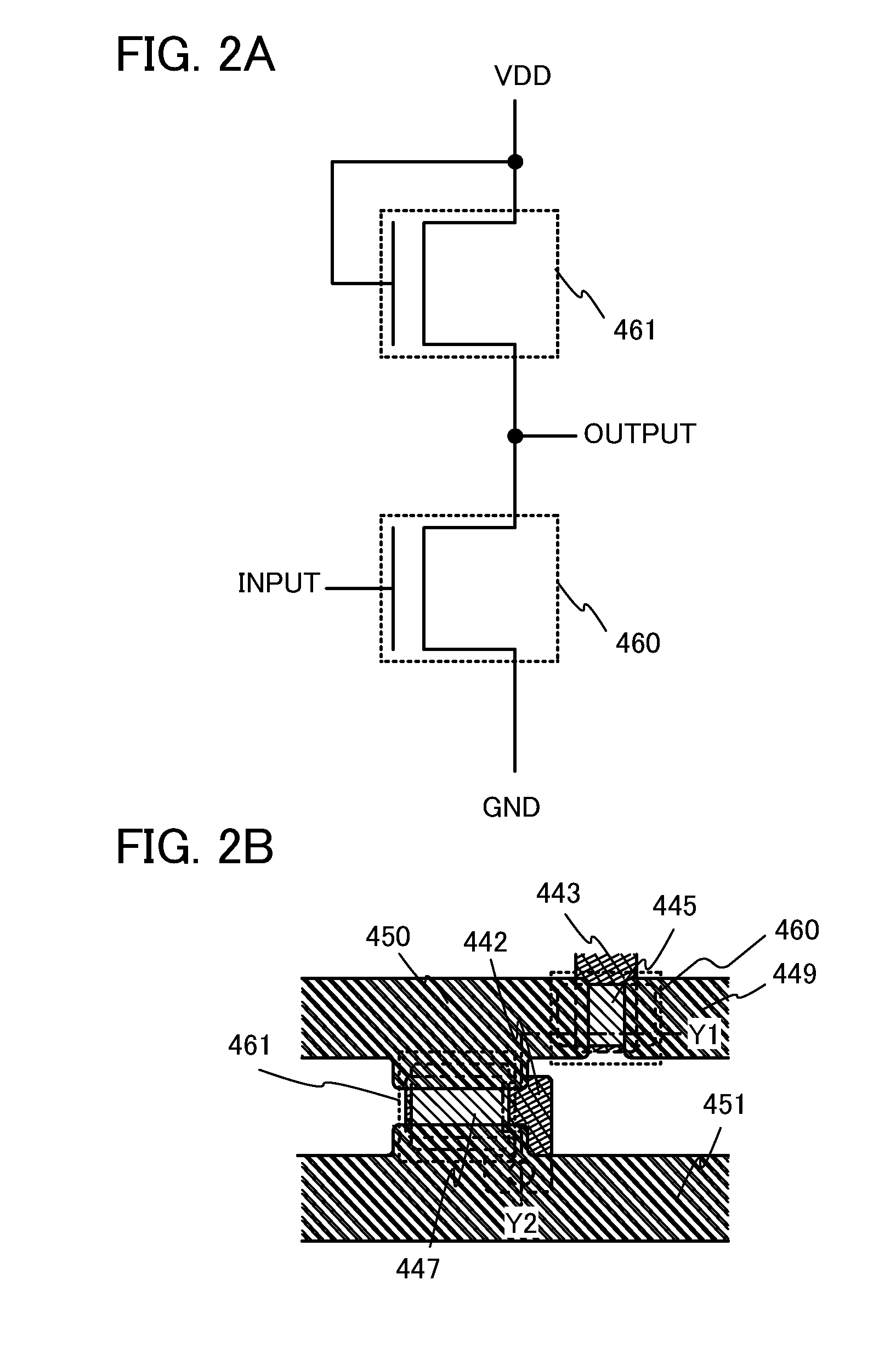Display device
a display device and display technology, applied in the field of display devices, can solve the problems of increasing manufacturing costs, and achieve the effects of reducing manufacturing costs, excellent electrical properties, and high reliability
- Summary
- Abstract
- Description
- Claims
- Application Information
AI Technical Summary
Benefits of technology
Problems solved by technology
Method used
Image
Examples
embodiment 1
[0062]In this embodiment, an embodiment of the present invention will be described based on an example in which an inverter circuit is formed using two n-channel thin film transistors.
[0063]A driver circuit for driving a pixel portion is formed using an inverter circuit, a capacitor, a resistor, and the like. When two n-channel TFTs are combined to form an inverter circuit, there are two types of combinations: a combination of an enhancement type transistor and a depletion type transistor (hereinafter, a circuit formed by such a combination is referred to as an “EDMOS circuit”) and a combination of enhancement type TFTs (hereinafter, a circuit formed by such a combination is referred to as an “EEMOS circuit”). Note that when the threshold voltage of the n-channel TFT is positive, the n-channel TFT is defined as an enhancement type transistor, while when the threshold voltage of the n-channel TFT is negative, the n-channel TFT is defined as a depletion type transistor, and this speci...
embodiment 2
[0079]Although the example of the EDMOS circuit is described in Embodiment 1, an equivalent circuit of an EEMOS circuit is illustrated in FIG. 2A in this embodiment. In the equivalent circuit illustrated in FIG. 2A, a driver circuit can be formed in either case: a case where a first thin film transistor 460 and a second thin film transistor 461 are both enhancement type n-channel transistors, or a case where the first thin film transistor 460 is an enhancement type n-channel transistor and the second thin film transistor 461 is a depletion n-channel transistor.
[0080]It can be said that it is preferable to use the circuit configuration illustrated in FIG. 2A in which enhancement type n-channel transistors of the same type are combined for the driver circuit. This is because in that case, a transistor used for a pixel portion is also formed of an enhancement type n-channel transistor which is the same type as that used for the driver circuit, and therefore the number of manufacturing ...
embodiment 3
[0093]In this embodiment, an example of a manufacturing process of an inverter circuit which is different from the process described in Embodiment 2 will be described using FIGS. 4A to 4C.
[0094]A first conductive film is formed over the substrate 440 by a sputtering method and the first conductive film is etched as selected using a first photomask to form the first gate electrode 441 and the second gate electrode 442. Next, the gate insulating layer 443 for covering the first gate electrode 441 and the second gate electrode 442 is formed by a plasma CVD method or a sputtering method.
[0095]Next, an oxide semiconductor film is formed by a sputtering method, and an n+-type layer is formed thereover.
[0096]Next, the oxide semiconductor film and the n+-type layer are etched as selected using the second photomask. Thus, an oxide semiconductor film 454 and an n+-type layer 455 are formed which are overlapped with the first gate electrode 441 with the gate insulating layer 443 interposed the...
PUM
 Login to View More
Login to View More Abstract
Description
Claims
Application Information
 Login to View More
Login to View More - R&D
- Intellectual Property
- Life Sciences
- Materials
- Tech Scout
- Unparalleled Data Quality
- Higher Quality Content
- 60% Fewer Hallucinations
Browse by: Latest US Patents, China's latest patents, Technical Efficacy Thesaurus, Application Domain, Technology Topic, Popular Technical Reports.
© 2025 PatSnap. All rights reserved.Legal|Privacy policy|Modern Slavery Act Transparency Statement|Sitemap|About US| Contact US: help@patsnap.com



